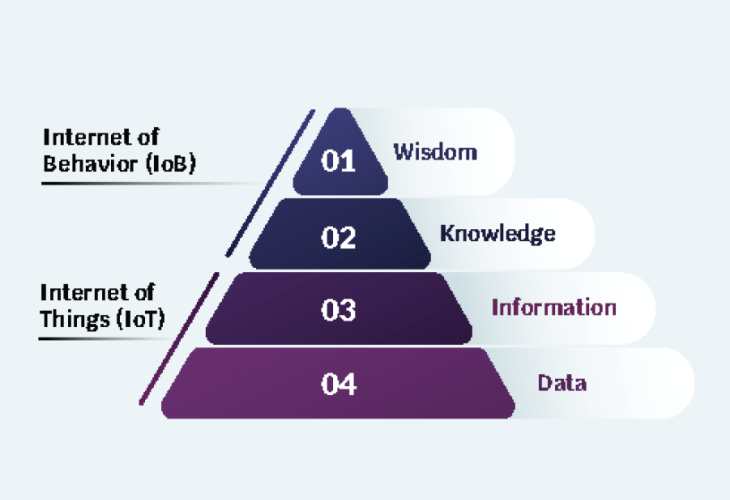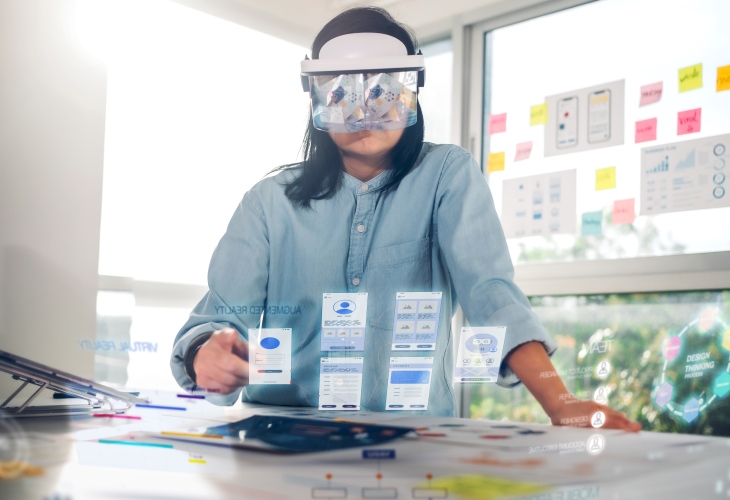The great advances made in the area of information technology over the past few decades have reached a perfect confluence. As the dawn of the information age came up, humans were able to deploy IT solutions to build better communication tools and to make these tools even smarter. Technology, as applied to tooling brought things like CRM, ERM, and automation chain solutions. It also changed how humans interacted with each other with the rise of social media platforms. As our tools got more intelligent, the era of the Internet of things (IoT) was born. The sheer ubiquity and the pervasive nature of smart tools and devices around the world and in our lives have yielded a vast trove of information about ourselves in a way that was not previously possible. Our behavior, interactions, and mental posture are usually expressed in how we interact with the material world via tools and systems.
These smart tools guarantee that human behavior can now be tracked individually and collectively at a volume and scale that was not previously possible. Advances in Big Data provide the means to collate, curate, and correlate data to reveal patterns and dynamics that were previously unknown to observers.
In 2020 Gartner listed the Internet of Behaviors as the number one item in its strategic technology trends for 2021. This shows that IoB will be a game-changer in the years to come.
Forbes magazine, in 2021, declared that IoB was the next frontier for smart technology and that it would enhance the human experience in many spheres of life.
The field of psychology has studied human behavior extensively and the knowledge gleaned has been used to shape policy, commerce, business, marketing, etc. Often individuals would enroll to be part of a small psychological study and small studies are conducted with small data sets. The explosion of human usage and human behavioral data presents an unprecedented opportunity for researchers to scientifically observe humans in specific situations and times. They can test psychological hypotheses, discover previously unknown social dynamics, and predict trends.
IoB lies at the intersection of psychology, Internet of Things (IoT), and Big Data Analytics. It is able to yield intel not only on how humans behave but the likely motivation behind this behavior. It unlocks social and subconscious information that even the data subject may not be aware of.
The behavior of humans has a real impact on businesses, government, and academia. This explains the painstaking effort that has gone into unlocking the dynamic web of interconnected factors, subtle catalysts, hidden triggers, and remote causes that influence us. Even more important to researchers are the conditions that indicate or predict trends before they are ever obvious. The volume of data that needs to be computed and correlated is something that has previously been difficult to gather and sustain. The psychological motivation for IoB has always been present but the tolls to achieve it were lacking. While the problem of data sources has now been solved by IoT, the problem of data analysis has been resolved by patterndetecting artificial intelligence and big data manipulation techniques.
An article by Science Direct envisions IoB as the topmost end of a pyramid built on data analytics and IoT.
Complex human interactions are difficult to quantify at scale and macro-trends are often detected very late in their development. At that point, it is often too late to make changes to capture the upside and avoid the pitfalls. Many large organizations that went bankrupt could have benefitted from early warning systems that signaled changes in the behavior of the market. One can only imagine that many corporate interests are watching the emergence of IoB eagerly.

Benefits of IoB
In determining the benefits of IoB, it is important to evaluate the benefits carefully to ensure that the benefit to one party is not exploitative to another party.
Customer Service
One area where the benefits of many parties would coincide is the delivery of highly delightful and proactive customer service. The ability to analyze past data or a current data-stream to anticipate user behavior is a powerful tool for service providers to use in order to provide customized services and tailored experiences to delight their customers. It can be deployed to provide Just-in-Time service that reduces wasted materials, effort, and time. The customer ends up with the right product they need and the service provider retains the customer’s loyalty. With this benefit comes a concern. While humans enjoy customized service, it may become unnerving to know that a corporate interest knows so much about us that they can predict our lives. It also becomes very interesting when organizations compete for the same customer.

In a bid to out-perform each other, they promise even more customized service and it feels like an invasion of the privacy of the customer.
Societal Improvement
Societies change due to various factors. It could be one cohort coming of age, reaching critical mass, or change arising from a major economic shift. Public officer holders are charged with advancing the security and well-being of their jurisdiction. This often involves making policy and fiscal decisions that affect the lives of citizens over an extended period of time. These officials need insight into complex human behavior on a large scale. This is information that ensures that social strategy remains relevant for the present and the future. IoB can provide statistical models that forecast the likely effectiveness of a proposal and the resultant dynamics it creates. With this, public leaders would be guarded against solving a $10,000 problem that creates a $10,000,000 problem in 2 years’ time. The analysis and data that IoB provides could also provide early warning signals that indicate where a social policy is causing unintended stress in another aspect of society. IoB could be the tool that helps proactively address the issues of homelessness, addiction management, carbon footprint per user, crime and illegal behavior, and reduce public resource wastage.
One obvious problem with this use case is that the citizens may feel that such precise data could be targeting a specific segment, class of society, or intruding upon their expectations of privacy.
Product Development
Product design has come a long way from the clunky and oddly-shaped designs of the early industrial age. Now designers of everything, from user interfaces to fighter jets, understand and appreciate the need to “design for humans”. The human-centered design succeeds when designers are keenly aware, not only of the use case but also of the user characteristics. By deploying IoB, they can learn how people use these eproducts and evolve ways to guide better usage or discover new ways to use the product or service.
Sometimes, people do not use a product in the way the producer imagined, or people adapt the usage in ways that could not have been foreseen. IoB would be a great feedback mechanism for producers and this leads to more life-enriching solutions.
Ethical Concerns
As with all tools and techniques that humans develop, IoB can be applied in a benevolent or malevolent manner. This raises the ethical question of the allowable boundaries of IoB. There are many pitfalls in the misapplication of this technology. Some of these are explored below.
Privacy Abuse
One concern that immediately comes to mind is that of privacy. Corporations would certainly be interested in acquiring as much data as possible about individuals, but for the most part, users are not keen on giving up so much insight into their personal lives. As news reports of data abuse and mishandling increase, one would only expect the reluctance to grow. Some other factors to consider around privacy are the issue of culture and legal jurisdiction. In one culture and jurisdiction, any use of data is permissible unless expressly forbidden, while in another, any use of data is forbidden unless expressly permitted. Another example is the difference in privacy philosophy between the US and the EU. In the EU, privacy is protected because privacy should be protected, whether there is malicious intent or not. In the US, however, the underpinning philosophy is that privacy protection is only important to prevent malicious intent. These two philosophies color the privacy law in both jurisdictions. Human data, on the other hand, and corporate interest cross borders rapidly and are virtually impossible to lock down to one jurisdiction.
IoB related technology and investment leaders will have to navigate an increasingly complex privacy ecosystem before they can reach their full potential.

Influence Campaign
If IoB can build models to analyze user behavior, it can also be reimagined to produce models to influence user behavior. This is the most sinister aspect of IoB – the capacity to produce information and perceptions that predictively alter user behaviors and engineer social change. An individual or group of individuals could be led to behave a certain way without knowing they are being manipulated. This would find great use among corporate interests, authoritarian regimes, and shadowy organizations. The very concept of “individual choice” would be challenged because the chooser is now unsure if the action was from him or if he was manipulated.
There is certainly a huge philosophical discourse to be had around the ability of IoB to influence people. This is why this technology will be one of the hardest questions that will ever be handled by privacy practitioners and lawmakers.
What Is Next?
As organizations and industry professionals develop their strategy, they should keep this IoB technology in focus because of its ability to change service delivery models and society itself. Here are some things to consider:
Keeping Up with Opportunities
Business leaders should look for ways to ethically leverage IoB to drive customer engagement. They should actively court customer participation in the conception and design of product and service delivery. They should also see IoB as a scalpel that allows strategy to be focused and fit for purpose. Officers in strategic procurement decision positions should look out for vendors who are leading the adoption of this technology.
Keeping Up With the Risk
Organizations and individuals need to be aware of the evolving risks around IoB and the ways in which threat actors leverage this technology to achieve their objectives. Organizations that deploy IoB should understand the social perceptions that it creates and enhance their cyber defense to protect the PII of data subjects. Individuals should educate themselves on how the technology works and apply due diligence when using IoT, especially in facilities or environments where confidential data emanates.
Keeping Policy and Standards Up to Date
The development and revision of standards, frameworks, and policies will have to be more agile. As IoB stakeholders become even more creative in the use cases for IoB, standards have to evolve to ensure they can anticipate new developments or keep pace with current issues. There is a big risk that extant privacy and security standards will become inapplicable and unfit for adoption because they do not solve the challenges and risks that IoB technology poses.
IoB and the Future
Some may only see the dystopian effects of IoB, while others may only see the benefits to be reaped. The technology itself is neither benevolent nor malevolent, the people who use them are the ones that either use them for the benefit of humanity or otherwise. Technological advances, including IoB, will not make humans do anything malevolent they are not already capable of. It will not change us. It will only reveal us.









